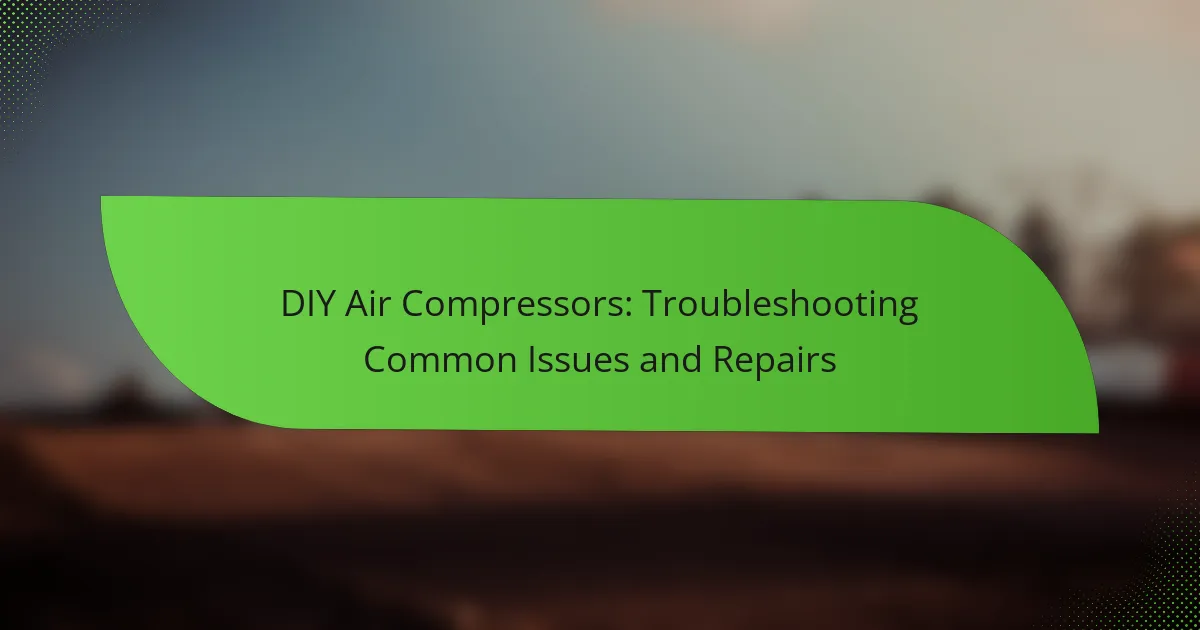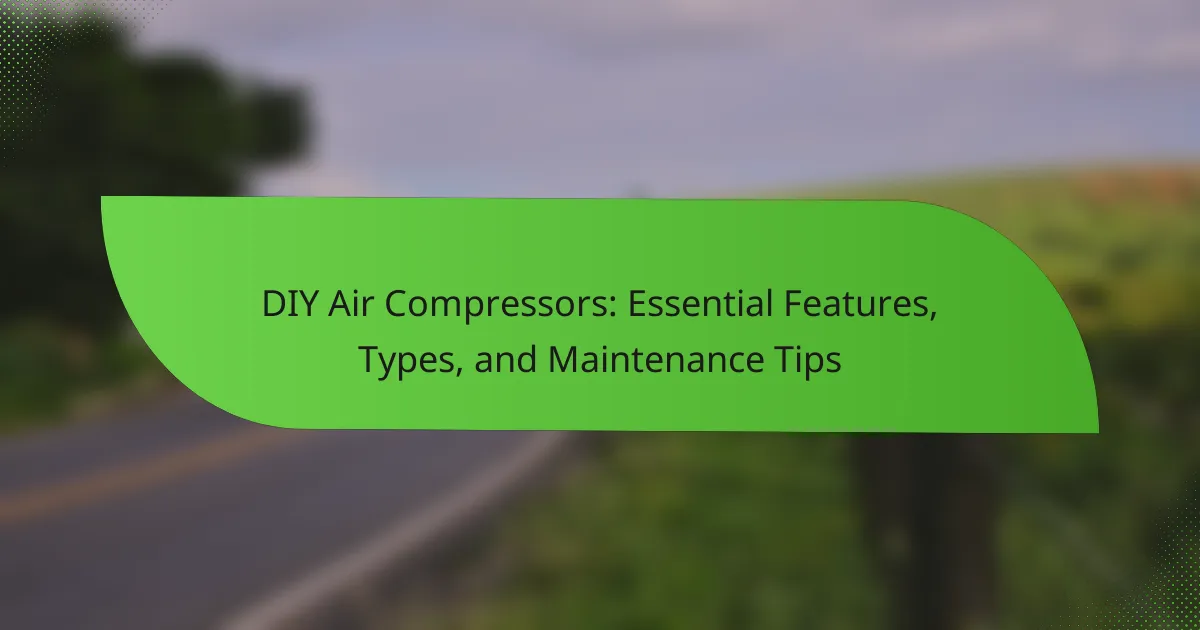DIY air compressors are homemade devices designed to compress air for various applications, such as inflating tires, powering pneumatic tools, and spray painting. This article provides a comprehensive cost analysis of building a DIY air compressor, detailing the components required for assembly, associated costs, and the time investment involved. It compares the total cost of DIY models to commercial options, highlighting potential savings and the value for money they offer. Additionally, the article emphasizes the longevity and versatility of DIY air compressors, showcasing their ability to provide significant long-term savings compared to hiring services or purchasing compressed air.
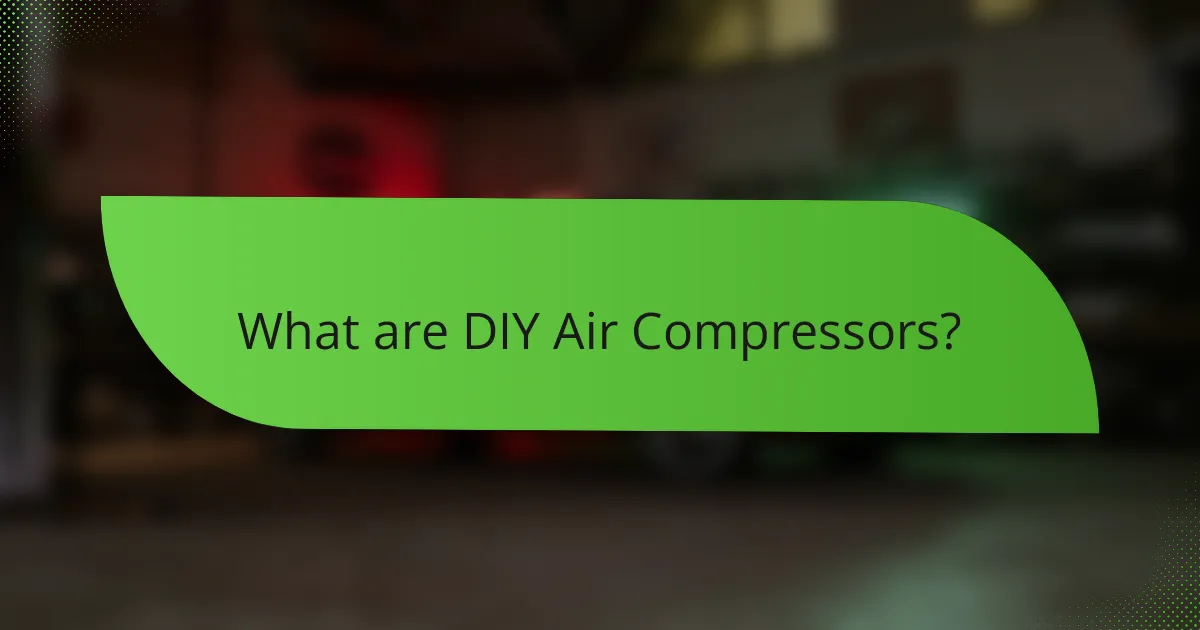
What are DIY Air Compressors?
DIY air compressors are homemade devices that compress air for various applications. They are often built using repurposed materials or modified existing equipment. Common uses include inflating tires, powering pneumatic tools, and spray painting. DIY air compressors can be more cost-effective than commercial models. They allow for customization based on specific needs and available resources. Many enthusiasts share designs and instructions online, making it easier for beginners to create their own. The efficiency and performance can vary significantly based on the materials and design used.
How do DIY Air Compressors function?
DIY air compressors function by converting power into potential energy stored in pressurized air. An electric motor or gasoline engine drives a piston within a cylinder. As the piston moves down, it creates a vacuum that pulls air into the cylinder. Upon the piston’s upward motion, the air is compressed and forced into a storage tank. This process increases the air pressure, enabling the compressor to store energy for later use. The compressed air can then be released for various applications, such as powering tools or inflating tires. DIY air compressors often utilize readily available components, making them cost-effective for personal use.
What components are essential for building a DIY Air Compressor?
The essential components for building a DIY air compressor include a motor, a compressor pump, an air tank, and a pressure switch. The motor powers the compressor pump, which compresses the air. The air tank stores the compressed air for later use. The pressure switch regulates the pressure within the tank, turning the motor on and off as needed. Additional components may include an air filter, pressure gauge, and hoses for air distribution. These components work together to create a functional air compressor system.
How does each component contribute to the overall performance?
Each component of a DIY air compressor plays a crucial role in overall performance. The motor provides the power necessary to compress air. A more powerful motor increases efficiency and reduces the time needed to fill the tank. The compressor pump is responsible for converting electrical energy into compressed air. Its design and quality directly affect the airflow rate and pressure output. The air tank stores compressed air for use. A larger tank allows for longer operation periods without needing to refill. The pressure regulator maintains consistent output pressure, ensuring tools operate effectively. The hoses and fittings facilitate air delivery. High-quality hoses minimize pressure loss and improve performance. Each component’s quality and compatibility determine the compressor’s reliability and lifespan. Together, these elements ensure optimal functionality and efficiency in DIY air compressors.
What are the primary benefits of using DIY Air Compressors?
DIY air compressors provide cost savings, customization, and convenience. Building your own compressor can significantly lower expenses compared to purchasing a pre-made unit. Customization allows users to tailor specifications to meet specific needs, such as pressure and capacity. Convenience is enhanced as DIY compressors can be designed for portability or specific applications. According to a study by the Home Improvement Research Institute, DIY projects can save homeowners up to 30% on equipment costs. Additionally, DIY compressors can often be repaired or modified easily, extending their lifespan and usability.
How do DIY Air Compressors compare to commercial options?
DIY air compressors typically offer lower initial costs compared to commercial options. A DIY model can be assembled for as little as $100, while commercial compressors often start at $300. However, DIY compressors may lack the durability and efficiency of commercial units. Commercial options usually come with warranties and customer support, which DIY models do not provide. Furthermore, commercial compressors often have higher air pressure and volume capabilities. They are designed for heavy-duty use, unlike many DIY versions. According to a study by Consumer Reports, commercial compressors generally last longer and require less maintenance. Overall, while DIY air compressors are cost-effective, they may not meet the performance needs of all users.
What specific tasks can be accomplished with a DIY Air Compressor?
A DIY air compressor can accomplish various tasks. It can inflate tires for vehicles, bicycles, and sports equipment. It can also power pneumatic tools like nail guns and spray guns. Additionally, it can clean hard-to-reach areas by providing compressed air for dusting. A DIY air compressor can also assist in painting projects by delivering a smooth finish. It is useful for blowing debris off surfaces, such as patios or workshops. Furthermore, it can be employed in automotive repairs for tasks like removing lug nuts. Lastly, it can aid in operating air-powered accessories, enhancing overall efficiency in various projects.
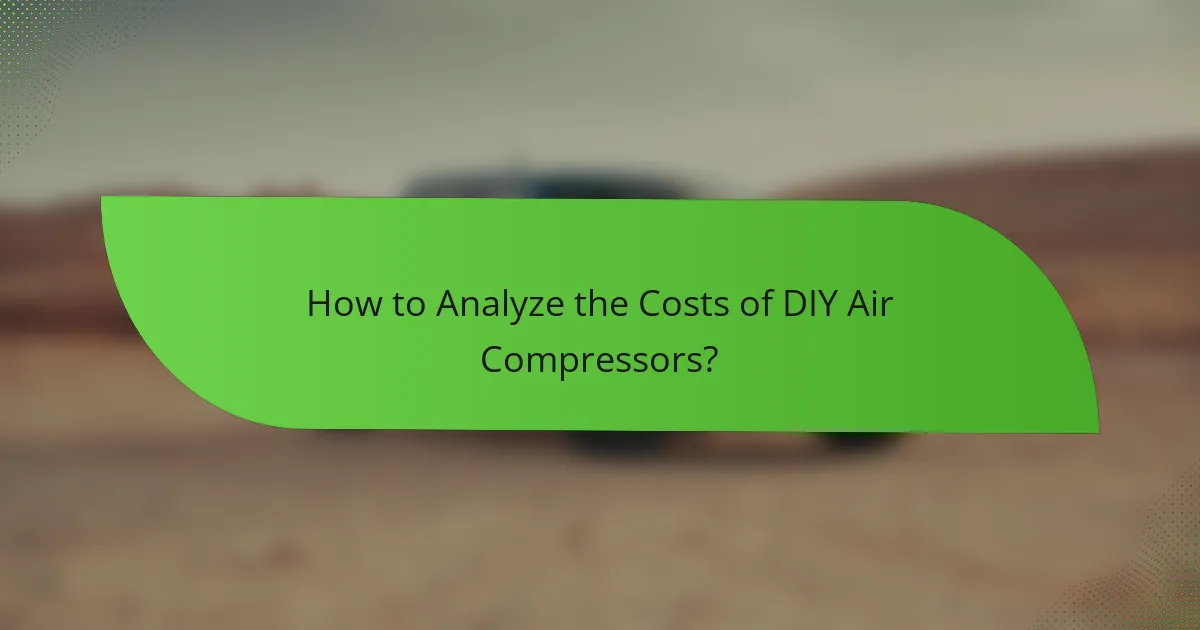
How to Analyze the Costs of DIY Air Compressors?
To analyze the costs of DIY air compressors, start by identifying all components needed for assembly. This includes the compressor motor, tank, fittings, and hoses. Next, calculate the cost of each component. Prices can vary widely based on quality and brand.
Include additional costs such as tools required for assembly and any safety equipment. Consider the time investment for building the compressor. This can affect overall cost if you value your time.
Compare the total DIY cost to pre-assembled air compressors available in the market. This will provide insight into potential savings or benefits.
Research shows that DIY projects can save up to 30% compared to retail prices, depending on materials used. This analysis helps determine if the DIY route offers better value for money.
What factors influence the overall cost of building a DIY Air Compressor?
The overall cost of building a DIY air compressor is influenced by several key factors. First, the quality and type of materials used significantly affect the price. High-quality components, such as motors and tanks, typically come at a higher cost. Second, the complexity of the design impacts expenses. More intricate designs require additional parts and expertise, increasing costs. Third, sourcing materials can vary in price depending on location and availability. Local hardware stores may have different pricing compared to online suppliers. Fourth, labor costs, if outsourcing any assembly or installation, contribute to the overall budget. Lastly, additional features, such as gauges or filters, can add to the total cost.
How do material choices affect the budget?
Material choices significantly impact the budget for DIY air compressors. Selecting high-quality materials often increases initial costs. For example, premium components may cost 20-30% more than standard options. However, these materials can enhance durability and performance. In contrast, cheaper materials may reduce upfront expenses but lead to higher maintenance costs. Studies show that long-term savings can offset initial investments in quality materials. Therefore, careful material selection is crucial for balancing upfront costs and long-term value.
What are the hidden costs associated with DIY Air Compressors?
Hidden costs associated with DIY air compressors include maintenance, repair, and energy consumption. Maintenance costs arise from regular upkeep, which may require replacement parts. Repair costs can accumulate if the compressor malfunctions due to improper assembly or usage. Energy consumption often increases with DIY compressors, leading to higher electricity bills. Additionally, safety equipment and tools needed for assembly can add to the overall expense. These hidden costs can significantly impact the perceived savings of a DIY project.
How can you budget for a DIY Air Compressor project?
To budget for a DIY air compressor project, start by identifying all necessary components. Key components include the motor, tank, pump, and accessories. Research the prices for each item from various suppliers. Estimate additional costs for tools and materials needed for assembly. Allocate funds for unexpected expenses, typically around 10-15% of the total budget. Create a detailed spreadsheet to track costs and adjust as necessary. This approach ensures a clear financial plan. A well-structured budget can prevent overspending and ensure project success.
What are the key steps in creating a budget for your project?
Define the key steps in creating a budget for your project. The key steps include identifying project goals, estimating costs, allocating resources, and monitoring expenses. First, clearly define what the project aims to achieve. Next, gather data to estimate the costs associated with materials, labor, and other resources. Then, allocate funds to different categories based on priority and necessity. Finally, regularly monitor expenses to ensure adherence to the budget and adjust as necessary. These steps ensure a comprehensive approach to budgeting, facilitating effective financial management throughout the project.
How can you prioritize spending on essential components?
To prioritize spending on essential components, first identify the critical parts required for functionality. Essential components typically include the compressor, tank, and motor. Allocate the largest portion of the budget to these items. Evaluate the quality and performance of each component based on user reviews and specifications. Investing in higher-quality components can lead to long-term savings and efficiency. Consider the overall cost versus value for each part. Prioritize components that directly impact performance and reliability. Research indicates that quality components can reduce maintenance costs by up to 30%. This approach ensures effective budgeting and maximizes value for money in DIY air compressor projects.
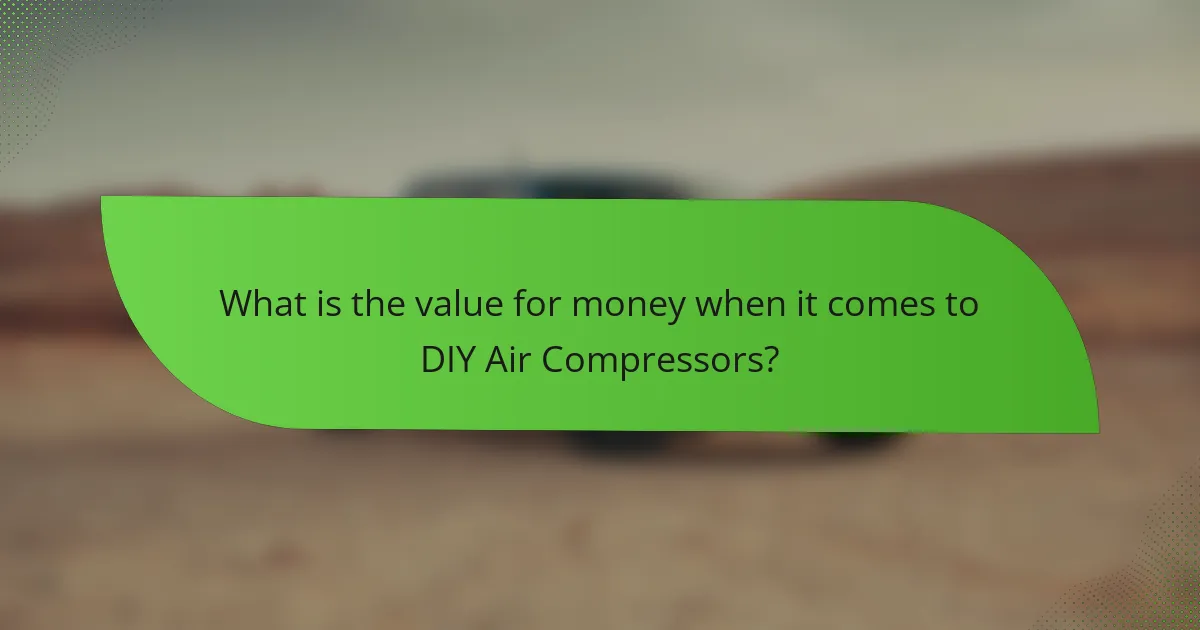
What is the value for money when it comes to DIY Air Compressors?
The value for money of DIY air compressors is generally high when considering their versatility and long-term savings. DIY air compressors can be used for various tasks, such as inflating tires, powering tools, and painting. The initial cost of a DIY air compressor typically ranges from $50 to $300, depending on the model and features.
In comparison, hiring services or purchasing compressed air can be more expensive over time. For instance, using a professional air service for painting a car can cost several hundred dollars, while a DIY compressor can achieve similar results for a fraction of that cost.
Moreover, many DIY air compressors have a lifespan of 10 years or more with proper maintenance. This longevity enhances their value for money, as the investment pays off through repeated use. Therefore, when evaluating the cost against functionality and durability, DIY air compressors often provide excellent value for money.
How do you evaluate the cost-effectiveness of a DIY Air Compressor?
To evaluate the cost-effectiveness of a DIY air compressor, compare total costs against potential savings. Start by calculating the initial investment, including parts and tools. Assess the operational costs, such as electricity and maintenance. Then, estimate the savings from using the compressor for tasks like inflating tires or powering tools. Consider the lifespan of the compressor to determine long-term value. Analyze similar commercial models for price and features. If the DIY version offers significant savings and meets your needs, it is cost-effective.
What metrics can be used to measure value for money?
Value for money can be measured using several metrics. Common metrics include cost-effectiveness, return on investment (ROI), and total cost of ownership (TCO). Cost-effectiveness evaluates the benefits gained relative to the costs incurred. ROI measures the profitability of an investment by comparing net profit to the initial cost. TCO accounts for all direct and indirect costs associated with ownership over time. These metrics provide a comprehensive view of financial efficiency and effectiveness.
How does long-term use impact the overall value?
Long-term use of DIY air compressors generally increases their overall value. This is due to the enhanced reliability and efficiency gained over time. Regular maintenance can lead to improved performance and longevity. Users often find that consistent operation justifies the initial investment. Additionally, frequent use may lead to a better understanding of the compressor’s capabilities. This knowledge allows for more effective application in various projects. Over time, the cost savings from reduced rental fees further contribute to value. Ultimately, long-term use solidifies the compressor’s role as a valuable tool in a DIY toolkit.
What tips can enhance the value of your DIY Air Compressor project?
To enhance the value of your DIY air compressor project, focus on selecting quality components. Quality parts ensure better performance and longevity. Use a reliable motor with sufficient horsepower for your needs. A motor rated around 1.5 to 2 HP is often ideal for home projects.
Incorporate a sturdy tank to store compressed air effectively. Tanks ranging from 6 to 30 gallons are common for various applications. Ensure proper fittings and hoses are used to minimize air leaks. Using high-quality hoses can improve efficiency and safety.
Consider adding a regulator and pressure gauge for better control. These components allow you to adjust air pressure for different tasks. Regular maintenance, such as oil changes and filter replacements, can prolong the compressor’s life. Following these tips can significantly enhance your project’s overall value and functionality.
How can proper maintenance extend the life of your DIY Air Compressor?
Proper maintenance can significantly extend the life of your DIY air compressor. Regularly checking and changing the oil prevents engine wear. Keeping the air filter clean ensures optimal airflow and efficiency. Draining the moisture from the tank prevents rust and corrosion. Tightening loose fittings reduces air leaks and increases performance. Inspecting hoses and connections for damage maintains safety and efficiency. Following these maintenance practices can enhance the longevity of your compressor. Consistent upkeep can lead to a lifespan increase of up to 50%.
What common troubleshooting tips can improve performance?
Regularly check and clean air filters to enhance performance. Clogged filters restrict airflow and reduce efficiency. Inspect and tighten all connections to prevent air leaks. Leaks can significantly decrease pressure and performance. Ensure the compressor is adequately lubricated to maintain optimal operation. Lack of lubrication can lead to increased wear and tear. Monitor the pressure settings and adjust them according to the manufacturer’s recommendations. Incorrect pressure can affect the tool’s performance. Lastly, ensure the compressor is placed on a stable, level surface. An unstable surface can cause vibrations that may impact performance.
DIY air compressors are homemade devices designed to compress air for various applications, including inflating tires and powering tools. This article provides a comprehensive analysis of the costs associated with building DIY air compressors, detailing essential components, their functions, and how to budget effectively for such projects. It also compares DIY models to commercial options, highlighting benefits, potential savings, and value for money. Additionally, the article outlines maintenance tips and troubleshooting strategies to enhance performance and longevity, ensuring readers gain a thorough understanding of DIY air compressors and their financial implications.
